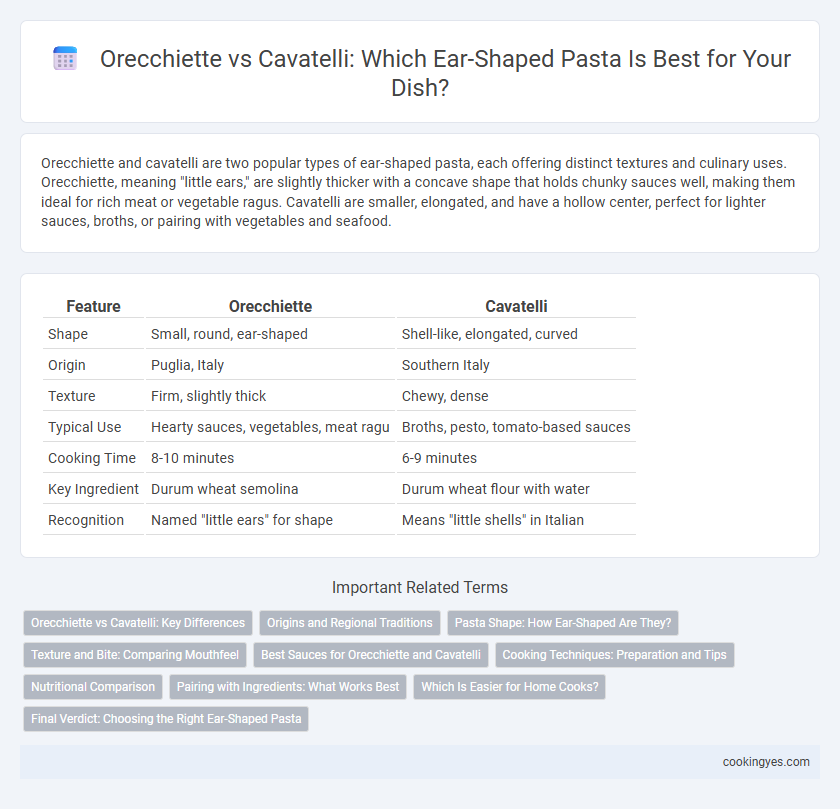Orecchiette and cavatelli are two popular types of ear-shaped pasta, each offering distinct textures and culinary uses. Orecchiette, meaning "little ears," are slightly thicker with a concave shape that holds chunky sauces well, making them ideal for rich meat or vegetable ragus. Cavatelli are smaller, elongated, and have a hollow center, perfect for lighter sauces, broths, or pairing with vegetables and seafood.
Table of Comparison
| Feature | Orecchiette | Cavatelli |
|---|---|---|
| Shape | Small, round, ear-shaped | Shell-like, elongated, curved |
| Origin | Puglia, Italy | Southern Italy |
| Texture | Firm, slightly thick | Chewy, dense |
| Typical Use | Hearty sauces, vegetables, meat ragu | Broths, pesto, tomato-based sauces |
| Cooking Time | 8-10 minutes | 6-9 minutes |
| Key Ingredient | Durum wheat semolina | Durum wheat flour with water |
| Recognition | Named "little ears" for shape | Means "little shells" in Italian |
Orecchiette vs Cavatelli: Key Differences
Orecchiette and cavatelli are both traditional Italian ear-shaped pastas but differ notably in texture and shape; orecchiette are wider, flat, and concave like small ears, while cavatelli are smaller, elongated, and resemble tiny hot dog buns. The dough for orecchiette is typically made from semolina flour and water, resulting in a chewier texture, whereas cavatelli often incorporate a bit of ricotta or eggs, making them softer. Orecchiette's shape holds chunky sauces and vegetables well, while cavatelli pair best with thicker, cream-based or meat sauces due to their hollow underside.
Origins and Regional Traditions
Orecchiette and cavatelli are traditional Italian pasta shapes originating from the southern regions of Puglia and Campania, respectively, each deeply rooted in local culinary heritage. Orecchiette, meaning "little ears," are hand-formed in Puglia to resemble small, curved discs, often served with broccoli rabe or tomato-based sauces reflecting the area's agricultural abundance. Cavatelli, shaped like small, elongated shells, are crafted in Campania and Molise, traditionally paired with hearty ragu or ricotta, showcasing the rustic simplicity of these regional traditions.
Pasta Shape: How Ear-Shaped Are They?
Orecchiette and cavatelli both feature ear-shaped designs, but orecchiette resemble small, concave discs with a more pronounced cup-like shape, closely mimicking the human ear's curvature. Cavatelli have a looser, elongated shape with a slight depression, appearing less like a definitive ear and more like small shells or mini hot dog buns. The distinct curvature of orecchiette makes them ideal for holding chunky sauces, while cavatelli's shape provides a firm bite suitable for thicker, creamier sauces.
Texture and Bite: Comparing Mouthfeel
Orecchiette features a slightly thicker, concave shape that offers a firm yet tender bite, creating a satisfying mouthfeel with a smooth surface that holds chunky sauces well. Cavatelli, resembling small, rolled shells, delivers a denser and chewier texture with a ridged exterior that enhances sauce adherence and provides a more substantial bite. Both pasta types excel in pairing with robust sauces, but orecchiette's softness contrasts with cavatelli's pronounced chewiness, offering distinct textural experiences.
Best Sauces for Orecchiette and Cavatelli
Orecchiette pairs best with chunky vegetable sauces like broccoli rabe and sausage, as its concave shape holds bits of sauce and ingredients effectively, enhancing texture and flavor. Cavatelli excels with thicker, creamier sauces such as ricotta or slow-cooked tomato ragu, where its ridges capture the creamy or hearty components perfectly. Both pastas complement rustic, robust sauces, but orecchiette favors lighter, vegetable-based blends while cavatelli suits rich, dense sauces for optimal taste.
Cooking Techniques: Preparation and Tips
Orecchiette requires a rolling technique where small dough discs are pressed with the thumb to form a concave shape, ensuring even cooking and sauce adherence. Cavatelli is shaped by dragging small dough pieces across a ridged surface, creating grooves that capture sauce effectively and deliver a chewy texture. For both, using semolina flour and resting the dough improves elasticity, while cooking in boiling salted water until al dente preserves the pasta's unique shape and bite.
Nutritional Comparison
Orecchiette and cavatelli both originate from Southern Italy and are popular ear-shaped pasta varieties, each offering distinct nutritional profiles. Orecchiette typically contain around 200 calories, 7 grams of protein, and 1.5 grams of fat per cooked cup, while cavatelli provide approximately 210 calories, 8 grams of protein, and 1 gram of fat per serving. Both pastas are low in saturated fat and offer a good source of carbohydrates, but cavatelli slightly edge out in protein content, making them a preferable option for those seeking higher protein intake in their meal.
Pairing with Ingredients: What Works Best
Orecchiette, with its concave shape, captures chunky sauces and pairs exceptionally well with hearty vegetables like broccoli rabe and rich, meaty ragus, enhancing every bite. Cavatelli's smaller, denser form excels at holding lighter sauces such as garlic-infused olive oil or simple tomato-based dressings, along with shellfish or Parmesan cheese. Each pasta's texture complements specific ingredients, making orecchiette ideal for robust and savory combinations, while cavatelli suits delicate, subtly flavored dishes.
Which Is Easier for Home Cooks?
Orecchiette, with its smooth, concave shape, is generally easier for home cooks to form as it requires a simple thumb-press technique on small dough discs. Cavatelli, shaped by rolling small strips of dough over a surface or finger to create ridged, shell-like pieces, demands slightly more dexterity and practice. Home cooks seeking simplicity and quicker preparation often prefer orecchiette for its straightforward shaping process.
Final Verdict: Choosing the Right Ear-Shaped Pasta
Orecchiette features a distinct concave shape resembling small ears, offering a slightly thicker texture perfect for holding chunky sauces or vegetables. Cavatelli, characterized by its elongated, rolled form with a subtle indentation, provides a denser bite ideal for cream-based sauces or hearty ragu. Selecting between orecchiette and cavatelli depends on the desired sauce pairing and texture preference, with orecchiette excelling in capturing chunky ingredients and cavatelli delivering a robust mouthfeel for rich flavors.
Orecchiette vs cavatelli for ear-shaped pasta Infographic

 cookingyes.com
cookingyes.com